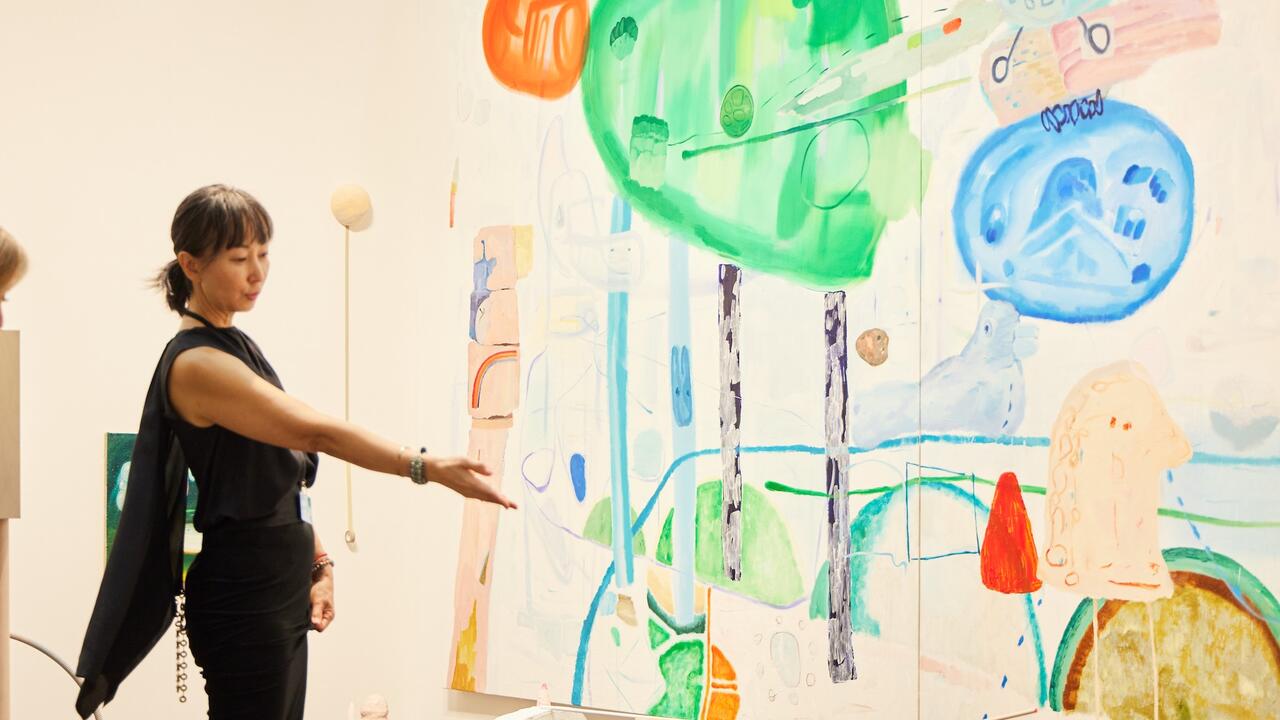In-A-Gadda-Da-Vida

'In-A-Gadda-Da-Vida' is the dribbling brainchild of Damien Hirst, Sarah Lucas and Angus Fairhurst. The title of the show was lifted from the song 'In the Garden of Eden' from Iron Butterfly's multi-platinum psychedelic LP of 1968 - it was how the words sounded when sung by the drunk lead singer. The show consists of numerous expensive looking vitrines, brightly coloured wallpaper and an outsized Spam sandwich and could conceivably exist as a spoof exhibition scene from an Austin Powers movie. Psychedelically charged it takes on the Big Questions: life, death, global commerce, the class system, media signifiers, the lot. Yeah baby, let the love-in commence!
The undoubted brilliance of Hirst's life and death Goth epic A Thousand Years (1990) has given way to a flabby comic book depiction of death-the-great-bed-wetter. Two vitrines Adam & Eve Towards the End (1999-2004) and Adam and Eve Exposed (2004) house Hirst's fictionalized account of the last days of the perpetrators of original sin. On the mortician's table Adam and Eve's plastic genitalia are exposed as their chests pneumatically rise and fall. The genitals, the somatic symbol for desire and creation presumably exist here to remind us of human fragility and fallibility. Either influenced by the John Fowles novel or The Jam song, another vitrine titled The Collector (2003-4) contains exotic butterflies and a mechanized mannequin of a microscope-fiddling figure. The sentiment Hirst expresses here is the cold fact that we destroy the things we love - or at least collectors can.
Metaphoric illustration is again order of the day in Lucas's Christ You Know It Ain't Easy (2003). Constructed from Marlboro Lights, Christ has been nailed to the George Cross. Lucas, it appears, has had a difficult time giving up cigarettes. In The Man Who Sold the World (2004) the cabin of a Leyland truck has been done over with tabloid images of topless models, next to the steering wheel a beefy mechanical arm pumps, wanking thin air. Two smaller works recall Lucas' Bunny (1997) - coloured tights stretched over school chairs in danger of being torn by outsized male genitalia. GI helmets made from Coca-cola and Spam tins are also in evidence. It's hard to forget the kick of Lucas' Dr Marten shoe, replete with razor blade or Friday night kebab transformed into a Rene Magritte, and these domestically scaled works retain some of the artist's ability to wring new form from the basest and most banal of materials. Unfortunately though, the presentation here is cosy and woolly, lacking the material bite and energy of Lucas' former manifestations.
The exhibition notes remind us that Lucas has a 'powerful feeling in her work for her working-class roots'. Presumably this is the cigarette smoking, beer swilling, white bread eating, pizza chomping, George Cross wearing iconography liberally sprayed around the gallery. It's pitifully underdeveloped as either a statement or critique of the British class system. But perhaps this form of dumb sophism is the point - to be drawn into any real discussion is to risk having an opinion.
In Fairhurst's The Birth of Consistency (2004) an outsized resin ape stares at its reflection in a mirrored pool. There's some suggestion that Fairhurst - who has employed gorillas as a motif for over a decade now - is touching upon the bigger picture; the birth of consciousness to be exact, courtesy Lacan's mirror phase theory. Elsewhere in the gallery another ape stares dumbfounded at an estranged limb and a giant resin banana sits like the punch line to a forgotten gag.
Individually one or two of the works could hold attention for a short while but en masse they get lost in the soup, as one statement piece squeezes the life out of the next. Nobody likes the class swot but this level of enquiry leaves you gasping for something to mentally grapple with. The biggest laugh to be had is in the A4 exhibition handout which includes the line 'the exhibition contains works that some visitors may find challenging'. This level of enquiry might look good on the young would-be cultural assassin but like hotpants on the middle aged, kind of naff as the spread begins. If it used to seem ballsy, now it represents little more than dominant economies, played out sculptural tropes and tired wordplays.
This is the generation of artists that mixed DIY punk sensibility with hard nosed Thatcherism, and who, in the dark economic twilight of the 1980s helped kick-start a flagging commercial and creative scene in Britain. For this credit is due. However, the former has all but gone in the shifting tides that is the art world and given it's 15 years since graduation day its all starting to look very conservative. As an alternative exhibition title Ogdens Nut Gone Flake (1968), The Small Faces masterwork of satire could equally have worked. It's an album in which the kings of Mod quietly took the piss out of the bloated boho sensibilities of the hippies that swarmed to the once groovy capital.
















